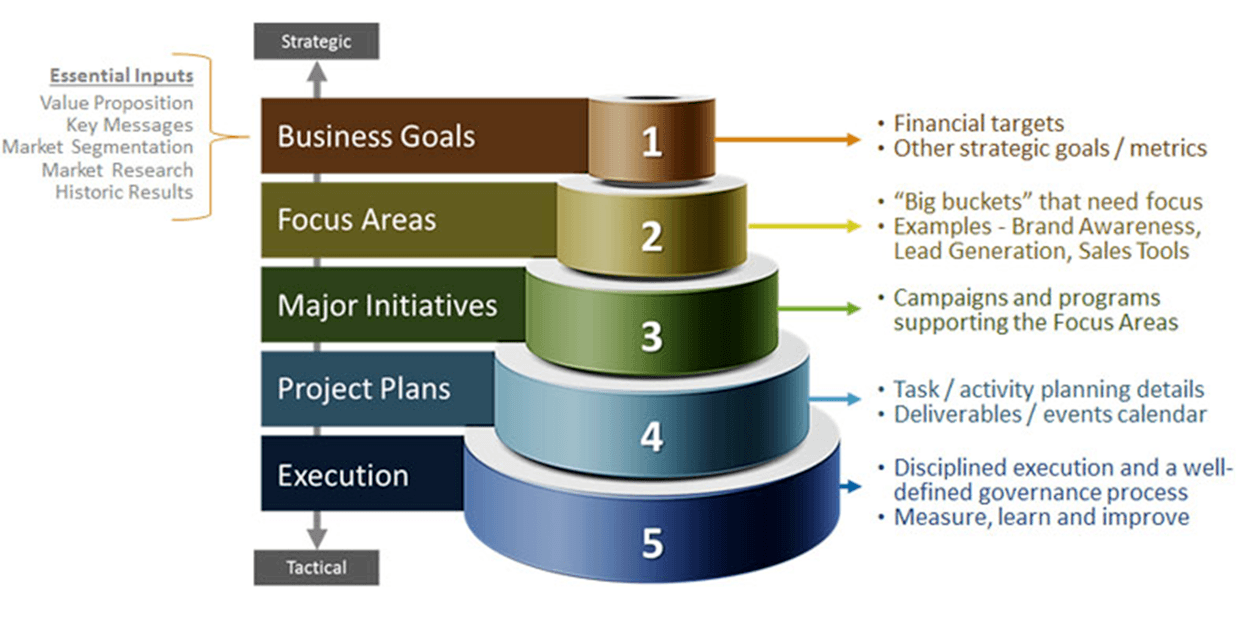
In the famous words of Benjamin Franklin, “By failing to prepare, you are preparing to fail.” Most people understand that proper planning is a crucial ingredient of success, but creating and executing successful marketing plans is a real challenge for most companies. This principle also impacts sales, human resources, operations, and all other major business functions. Although few would argue against the merits of preparation, many companies don't step back and carve out the time needed to do it properly.
Numerous studies show a massive disconnect between their strategic marketing and business plans and the intended results. The statistics range from a dismal 3% to a paltry 33% success rate. Although there are many other specific factors, the following are key reasons why things usually go wrong from the planning perspective:
- Lack of planning experience or a solid planning process.
- Not enough research and data used in the decision-making.
- Not enough detail put into the plan.
- Unrealistic goals relative to the available resources.
- Lack of buy-in from those who will execute the plan.
- A weak or non-existent governance process.
5-Step Marketing Management Framework
To help make your planning more structured and effective – you might benefit from the following framework. The basic premise is that you start at the most strategic level of thinking. Then you continually break things down into more tactical activities. Everything should align closely with your key inputs and business goals.

Building better marketing plans requires some Essential Inputs that form the foundation when selecting your activities and mapping out how you will achieve them. If you don't have these inputs or haven't revisited them lately, some homework should be done first.
Arguably, this is a one-time event, but things often change over a year and sometimes during a quarter. At the very least, it’s wise to re-validate your data and assumptions before the real planning begins
Basic Guidelines for Marketing Plans
#1 Business Goals
These are the goals you are planning to reach during an upcoming period. Marketing examples could include things like the number of leads created, website and social media engagement targets, or brand building metrics. There can also be important large-scale strategic goals, such as deploying a marketing automation tool or hiring for several key roles during a quarter.
During this phase, you also need to estimate the time, cost, and energy it will take to achieve your plan. Make sure the budget and resources are abundant enough to get the work done. Being unrealistic about your goals is a recipe for failure.
#2 Focus Areas
This step defines the major Focus Areas that need attention during the execution period. What are the most important “big buckets” of your plan, and how do they align with your Business Goals? If you look at the examples in the framework, you would be right in assuming that these stay relatively consistent. However, there will be varying degrees of effort put into these Focus Areas at any given time since you can’t do everything at once. Usually, there are 4-6 of these in total.
#3 Major Initiatives
Major Initiatives feed into and support your Focus Areas. For example, if you need to create more brand awareness this year, your Major Initiatives may include things such as SEO and content marketing, social media, digital advertising, public relations, or events.
These can also be more programmatic. Let’s say client retention is an issue for your company and a Focus Area this quarter. In this example, Major Initiatives might include creating programs to improve communications with your customers, such as a newsletter, or a rewards program to help increase loyalty.
#4 Project Plans
Specific project planning is the area where many fall short. There is often a good high-level plan with the right mix of Major Initiatives, but a lack of detailed thinking at the activity and resource levels. By not working through this concisely, it’s easy to underestimate the work needed to execute effectively and on schedule.
When you hear “it took longer than we thought,” – it typically means a lack of detail in the planning phase. Whether it’s MS-Excel, MS-Project, or an online tool such as Teamwork (a personal favorite), the marketing team needs to map out the many moving parts of each Major Initiative to clearly understand who will do what, and when. Contingencies also need to be considered since priorities can change over time.
#5 Execution
To keep your Project Plans on track and running smoothly, you need a good project management process and strong governance. As mentioned earlier, you should employ a tracking tool to measure progress.
You also need regularly scheduled checkpoint meetings. Weekly usually works best while executing a quarterly plan, plus a monthly touchpoint and a longer 1 to 2-day yearly session. I can hear the groaning, but investing in this process is where the rubber meets the road. A steady cadence helps you identify and resolve issues before they side-swipe your projects and allows for mid-stream adjustments.
The final and critical aspect of execution involves measuring results and outcomes, analyzing the data, and making improvements for the upcoming period. This step may also lead you to "stop, do more, or try something different" decisions.
Conclusion
When you use a disciplined approach to create and execute achievable marketing plans that align with your goals, you will get better results! Putting in the time and effort upfront reduces frustration and provides better clarity, resource management, predictability, and desired outcomes.
Please share any ideas or thoughts you may have on this topic and contact us if we can assist in any way. To get notified when new articles are published, please hit the button!

Randy Fougere, President, Think2Grow Marketing
With a passion for building brand awareness and lead generation, I started Think2Grow for B2B clients looking to accelerate growth through better marketing strategy and execution - something I have been doing for more than 30 years now.

